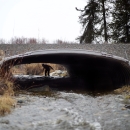States
MichiganThis project will replace two culverts on a channel that has been disconnected from the Maple River in Michigan since the 1800’s. Restoration of this historic connection into the Maple River will reduce flooding and erosion, provide high-quality habitat for fish, and ensure fish have access to safe cool-water habitat as climate change climate change
Climate change includes both global warming driven by human-induced emissions of greenhouse gases and the resulting large-scale shifts in weather patterns. Though there have been previous periods of climatic change, since the mid-20th century humans have had an unprecedented impact on Earth's climate system and caused change on a global scale.
Learn more about climate change impacts water temperature. Species benefiting from this project include brook trout, lake sturgeon, and many other reptile, bird, mussel, fish and plant species in the area. The Maple River area is vulnerable to climate change and has experienced loss of both native fish and agricultural area due to flooding events. Restoring this channel will improve bank stabilization and preserve fish habitat. The Little River Band of Ottawa Indian Tribe will benefit substantially from the project through cultural restoration that includes the protection and expansion of existing indigenous Manoomin (wild rice) crop in the project area.
Project Quick Facts:
| Project Status | In Development |
| Location | MI, Muskegon & Newaygo County |
| NFPP Project Funding | $1,925,650 |
| Restoration Techniques | Culvert Replacement |
| Accomplishments | 5 Stream Miles Reopened, 300 Acres reopened |
| Partner Project Lead | Muskegon River Watershed Assembly |
The National Fish Passage Program combines technical expertise with a track record of success.
Implemented primarily through the Service's Fish and Wildlife Conservation Offices, the National Fish Passage Program provides financial and technical assistance to partners across the country. Since 1999, the program has worked with over 2,000 local communities, Tribes, and private landowners to remove or bypass over 3,400 barriers to fish passage fish passage
Fish passage is the ability of fish or other aquatic species to move freely throughout their life to find food, reproduce, and complete their natural migration cycles. Millions of barriers to fish passage across the country are fragmenting habitat and leading to species declines. The U.S. Fish and Wildlife Service's National Fish Passage Program is working to reconnect watersheds to benefit both wildlife and people.
Learn more about fish passage and reopen access to over 61,000 miles of upstream habitat for fish and other animals. Staff have expertise in fish migration and biology as well as financial, engineering, and planning assistance to communities, Tribes, and landowners to help them remove barriers and restore rivers for the benefit both fish and people.
Fish passage project proposals can be initiated by any individual, organization, government, or agency. However, proposals must be submitted and completed in cooperation with a Fish and Wildlife Conservation Office. (Please note that fish passage projects being used for federal or state compensatory mitigation or required by existing federal or state regulatory programs are not eligible for funding through the National Fish Passage Program.)
CONTACT A FISH PASSAGE COORDINATOR IN YOUR AREA TO GET STARTED.


